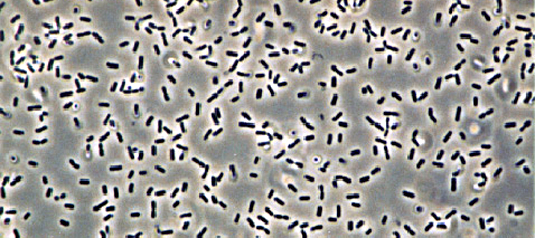The bacteria proliferate most effectively in this stationary state, while motile bacteria reproduce at a noticably lower rate.
In order to sustain and extend the colony, bacteria primarily require sufficient nutrients. Moving slowly means that nutrients are soon used up, but adventurous bacteria that decide to move out fast in search for a microbial Cockaigne may end up feeling lonely.
Which strategy offers the best prospects for the organisms? Should one specialize in growth or migration, or be a generalist and steer a balanced course?
Welcome to the world of theoretical biophysics, which makes theoretical physics look positively rigorous.

Bacillus Subtilis. Photo: Kookaburra / wikipedia.org. Link: Ludwig-Maximilians-Universitaet Muenchen
Ludwig-Maximilians-Universitaet Muenchen theoretical biophysicists in Professor Erwin Frey's group at the Nanosystems Initiative Munich created simulated scenarios, where the bacteria might seeded at the center of a plate containing nutrients. They gradually consume the nutrients available locally and are forced to colonize unpopulated territory.
“We have developed a special mathematical model in which these strategies compete with each other,” says Matthias Reiter, first author of the paper. “And this model enables us to prove that generalists are most successful.”
Experiments have only been performed on homogeneous bacterial cultures consisting of genetically identical cells but the theorists wanted to calculate the behavior of heterogeneous Bacillus subtilis populations. So they assigned a fixed migration rate to each bacterium, inherited by its progeny, and that rate determined the proportion of time the organisms spend in a motile state, as opposed to being engaged in nutrient uptake and proliferation.
Their numerical model derived that, initially, there is intense competition for the limited resources at the edge of the occupied territory. During this phase, individuals that reproduce fast and occupy as much space as possible are at an advantage. But they are soon superseded by colonies of generalists, which devote equal time to migration and proliferation. These gradually spread out, forming sectors as shown in the Figure.
The authors explain this behavior in terms of the invasion speed of so-called Fisher fronts. This speed is maximal in the case of a balance between growth and motility. Initially, colonies that steer a middle course form individual sectors, until they eventually occupy the entire invasion front.
“We intend to test our findings experimentally in cooperation with biologists, in order to compare our theory with experimental work,” Frey said. “It would even be possible to extend the model to more complex ecosystems, since it can, in principle, be transferred to all range-expansion phenomena in which growth and motility are complementary skills.”
Citation: Matthias Reiter, Steffen Rulands, Erwin Frey, 'Range Expansion of Heterogeneous Populations', Phys. Rev. Lett. 112, 148103 (2014) DOI: 10.1103/PhysRevLett.112.148103





Comments